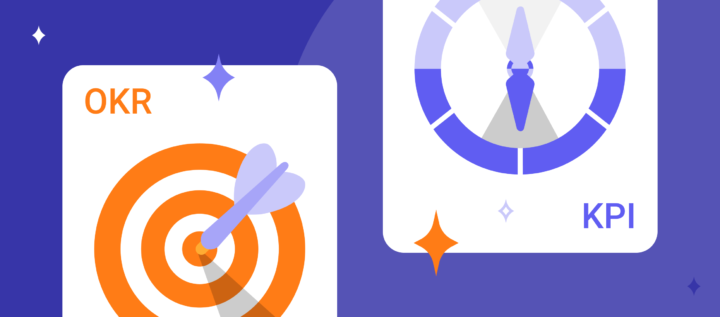Do Not Mix OKRs with KPIs Up: All You Need to Know About Goal Setting

Iliah is the Head of Product Operations at PandaDoc, the strategy, and OKR mentor. He’s also a product thinking coach and just a very interesting person to talk to. Ilya helped us shape our strategy and adjust our approach to OKRs. We’re grateful for his expertise, which helped us level up our strategic planning skills.
This article is a part of our series of posts devoted to the strategy and OKRs. We’ve previously published posts on how to develop a product strategy amidst uncertainty, what OKRs are, and how you can embed them in your team. Today we’d like to share an interview we recently had with Ilya. We’ve talked about why OKRs and KPIs are different and how companies can benefit if they introduce OKRs in their teams.
Elena from our growth team has interviewed Ilya. She’s also the founder of the Dashly library, and she was the first one to have her personal OKR.
— Hi, Ilya! We’ve known each other for a long time now. We discussed product strategies, you helped us formulate our strategic stakes, and facilitated our strategic workshop. You’re great at making things clear and simple. Please tell us, in a nutshell, why do companies need OKRs? It sometimes seems to be yet another framework used by everyone, not necessarily wisely. What issues does this framework help solve and in what way exactly?
— Hi, Elena! First, you must realize that OKRs are only worth introducing when you have a clear strategy. You need to know where you’re heading. If you don’t, OKRs may get you off course. You’re likely to set wrong objectives and head in the wrong direction.
OKRs help you see if you’re good at moving towards your destination.
Objectives are one part of the OKR concept. Though it may sound obscure in terms of the outcome, it should be concise and inspiring. The second part is a key result which is often a particular metric. But it’s not always like that. (Editor’s note: see our article where we defined two types of key results). A key result shows if you achieved your objective or not. When you set an inspiring objective, your KRs reflect reality. This is a recipe for success with the OKRs.
Read also:
👉 Live Chat Best Practices: 20 Hacks to Make Customer Service Better
👉7 Best Live Chat for eCommerce: Boost Conversion on your Website
👉 Top 5 live chat mobile app: find the best fit for your business
👉 Live Chat: How Online Chat Tool Can Help Your Business
👉 20 Best Live Chat Software for your website chat service
👉 Acquisition funnel marketing: Grow customer conversions at each step of user journey
👉 The top 15 inbound marketing tools: harness digital power and elevate your business
👉 10 best website personalization tools to deliver top-notch visitors experience
👉 7 best email capture tools: features and pricing compared for 2024
Another feature of OKRs is that all employees set objectives and key results, not just top managers. OKRs help teams sync up and head in the same direction. You can also engage all employees using them as team members will see how they personally can influence company achievements.
— Why is this approach different from KPIs if KRs are metrics, too?
— OKRs are not KPIs. First of all, you’re not getting bonuses if you meet your OKRs. This framework is mostly about team synchronization and meeting ambitious objectives. OKRs are not something you should achieve for 100%. The point is, if you achieve 100% of your OKRs, this means they were not quite ambitious. Vice versa, if you only meet 30% of your objectives, you’ve made too big bets.
Meeting around 70% of your OKRs means you’ve done a great job.
— What challenges do companies face when introducing OKRs? What can help them overcome these challenges?
— When trying to implement OKRs for the first time, companies reflect key results in metrics and fail.
If you didn’t move towards your strategic and tactical objectives before OKRs, you’ll find it hard to track metrics. Try shaping your key results as a set of actions you need to take, like releasing a feature or running an ad campaign. When your OKR term is over, you’ll be able to evaluate the success based on the done/not done principle.
From my experience, this MVP-like approach helps master the framework. Actions are defined at the company level, teams align on them and start working on the projects. After some iterations are successfully accomplished, you can switch to setting key results through metrics.
— Why is it so hard, to begin with, metrics, in your opinion?
— Companies are mostly bad at meeting metrics. They are interpreted differently and tracked with a careless attitude. Gathering quality data is a sophisticated task and not every company is capable of doing so. If we’re working with unbelievable figures, our work makes no sense at all.
And another important thing: only set those objectives and key results that you appreciate well. You need to be good at what you want to evaluate.
— Now that we’ve mastered basic concepts, let’s talk about introducing OKRs. Where should we set off, in your opinion?
— First, accept the fact that things don’t work the first time? Imagine your OKRs like this: “First, we’ll meet team leads, brainstorm OKRs, and will test-drive them for the next 3 months”. We’re not worried we might not achieve something. Our goal is to attach our actions to OKRs and see where we’re doing great”. This is an MVP approach.
Make sure you collect feedback after the first OKR iteration. You need to know the variety of opinions on what went good or bad and what you can improve.
When we finish our first OKR term and analyze our gaps, we can set new OKRs with stricter rules. We can try to formulate them via metrics and make them mandatory for all teams. During the third term, all OKRs should be reflected in metrics. When it comes to the fourth iteration, you can start setting personal initiatives. This is an evolutionary approach. It should get better with each iteration.
— I know three major ways of the OKR rollout: in the whole company, among team leads, or in one team at a time. Which one is the best, what do you think?
— It all depends on the company size. If you’re a team of 1000 people, the company rollout might be harmful. One part of the team won’t get the idea and what they should do, and the other one will rise against changes. You don’t want that kind of chaos, do you? If you’re a small team (50-100 employees), introducing the framework to its full extent is perfectly normal.
In large companies, introducing the OKR team by team works better. Experiment on a team that likes testing new approaches and wants to try the framework most of all.
— Well, let’s say we started setting OKRs. Turns out, it’s hard to align on the objectives. How can we tell if we set the right objectives and key results?
— First of all, you shouldn’t set lots of objectives. You should have between three and five objectives at company and team levels. Key results can reflect your objectives. It’s just like that: one objective — one key result. Or two to three key results, but no more than that.
Secondly, OKRs should not cover all your company activity. We have three objectives according to our top three priorities; this is where we’re heading.
Thirdly, make sure you engage your team in setting objectives. Managers set objectives, communicate them to teams, teams edit them, and send them back to managers, then managers edit them once again. There’s even the W framework including several iterations of discussing objectives. This framework covers the company level to each particular employee. It helps teams finalize and align on objectives and key results.
— What’s this framework, in a nutshell?
— I don’t know where it came from, but I saw guys from Miro publicly presenting the concept. So maybe it’s their creation. The main idea is that objectives and key results are cascaded in several stages:
- from the company level to teams;
- teams can say “no, it won’t work like that” and edit objectives;
- after the objectives are reviewed, the OKR draft gets back to the company level;
- the second iteration of editing takes place at the company and team levels;
- after two editing iterations, the company finalizes the OKRs.
— Ilya, that sounds great, but what’s with the operations? Do we take them into account? Teams used to work on their tasks before OKRs, and they devoted all their time to them. How can we combine everyday operations and strategic initiatives correctly?
— OKRs shouldn’t cover super small tasks. But you can use OKRs to improve your routine operations, like weekly emails. For example, your key results can be: 90% of emails are sent on time, the open rate of emails is X%. These initiatives help maintain the quality of your operations and even improve it.
— What else should we do not to let OKRs become a burden?
— Think ahead about where you’re going to keep your OKRs. There’s special software like Weekdone or 7Geese, also there are Google Spreadsheets. Make sure all your teammates have access to OKRs and understand them correctly.
OKRs should sound good. OKRs are a part of the company culture. Objectives motivate us, and Key Results show if we’re moving in the right direction.
You need to track OKRs once in a while. Hold a retrospective meeting after you complete the current OKR term. See how well synced up teams were, what went wrong, and what you need to focus on. Ideally, you should reflect back on your OKRs once in two weeks.
If your OKRs are reflected in metrics, you can see how well you’re approaching them or use percent performance scales.
— When we introduced OKRs in Dashly, our teammates didn’t understand why we needed them as we already had a lot of tasks, and teams had their own ways to evaluate performance. So, how can you sell the OKR idea to your team?
— Take your time to tell your team everything about OKRs: why you need them and why you use them. If you highlight it several times, people will see the value and take OKRs for granted.
You can also visualize your point like this: “Without OKRs, we’re heading separate ways, and with them, we’ll move in the same direction”.
You all should feel this vibe. Each quarter, we’re gathering together to discuss OKRs with all teams, wrap up and set new objectives. It helps employees get used to OKRs and appreciate the framework.
If you maintain these rituals, OKRs become a part of your company.
— How can we encourage an employee to meet their OKRs when they seem to be unable to achieve them?
— Engage teams to set OKRs. It’s an iterative process with reviews and corrections at all levels.
Author → content → the number of views → the conversion rate → the number of paying users → OKR achievement
Let’s consider an example of an author. I’m talking about you? The author’s major task is to increase the number of content views. We can evaluate how the number of views impacts the conversion rate to paying users. Hence, if you’re generating great content, you help achieve the whole company’s objective, namely, to increase the number of paying users.
— What are you doing in the OKR setting? Let’s say a company invites you to help them. You come there, pitch different frameworks, and identify the challenges of the team. What happens next?
— I’m always introducing OKRs together with the strategy. First, we start with understanding why we need the strategy. During a meeting, it gets clear to me that the company requires OKRs. In that case, we gather with the company management to define objectives and key results for the first OKR term. Then, managers align them with their teams.







